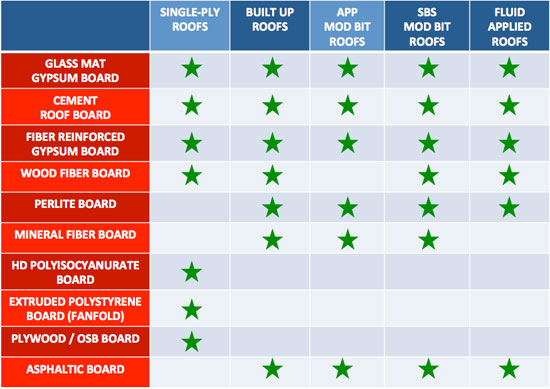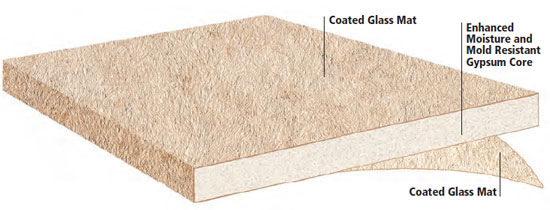Cover Boards for Low-Slope Roofing Systems
Which Cover Boards to Use With Which Roof Systems

Source: National Gypsum
With so many choices, the selection of a roofing cover board could be confusing. This chart shows which boards are compatible with each type of roofing system.
- Glass mat gypsum board works with all low-slope roof systems.
- Cement roof board also works with all low-slope roof systems.
- Fiber-reinforced gypsum board works with all low-slope roof systems.
- Wood fiberboard works with all systems except APP modified. This will not stand up to torching.
- Perlite board is a good fit with asphalt-based systems.
- Mineral fiberboard works with asphalt-based systems.
- High-density polyisocyanurate board is compatible with single-ply roof systems.
- Extruded polystyrene board/sheet also works best with single-ply roof systems.
- Plywood/OSB board is used with single-ply roof systems in high-wind areas.
- Asphaltic board is best used with asphalt-based systems.
- Note: Paper-faced gypsum historically has been used as a thermal barrier on the deck, although it is not currently recommended.
Pros and Cons of Various Cover Boards
Each type of roofing cover board has characteristics that add certain performance improvements to a roofing system. Some cover board types bring more benefits than others. This section discusses each type of board and the pros and cons in specifying these materials.
Glass mat gypsum board — The water-resistant, treated core of this type of cover board provides moisture protection. It also provides good heat resistance, which can help improve the fire classification when tested within a roof system. It has high compressive strength. Quite importantly, it is mold resistant. This board has high durability and hail resistance, and it limits sound intrusion into the building. It is used in wide range of roof systems and is readily available. Note that there are designated products for fully adhered systems.

Image courtesy of National Gypsum®
The treated core of this type of cover board provides mold resistance. The board also provides good heat resistance and other benefits.
Cement roof board — This cement-based cover board has high compressive strength for protecting the roof's insulating layer. It is noncombustible and is mold resistant. It is engineered for resistance to wind uplift and has excellent compressive strength.

Image courtesy of National Gypsum®
Cement-based cover board is well known for having high compressive strength for protecting the roof's insulation. Plus it is mold resistant is not combustible.
Fiber reinforced gypsum board — This product’s water-resistant, treated core provides moisture protection, good heat resistance, and can upgrade fire classification when tested within a roof system. It has high compressive strength, and is mold resistant. It is hail resistant and does well with foot traffic. It limits sound intrusion and has good wind uplift characteristics.
However, fiberglass is very friable, and creates fiberglass flying around on jobsite and causes itchiness for workers. It is difficult to cut board on jobsite. And it is very heavy, which increases rooftop-loading time, and is harder on installers. It has limited R-Value. When cut, scratched or damaged, the board becomes susceptible to moisture penetration, which makes it vulnerable to causing future moisture and mold problems. While cutting to modify board length or width is not very difficult, the cutting of holes for pipes and drains is difficult. The product comes coated on six sides from the factory, so once it’s cut, the coating no longer protects the gypsum/cellulose core of the product from moisture.
Paper-faced gypsum board — Although not recommended, it can be used as a thermal barrier on a combustible deck to improve the fire rating. , It limits sound intrusion, especially when used together with a gypsum-based cover board.









